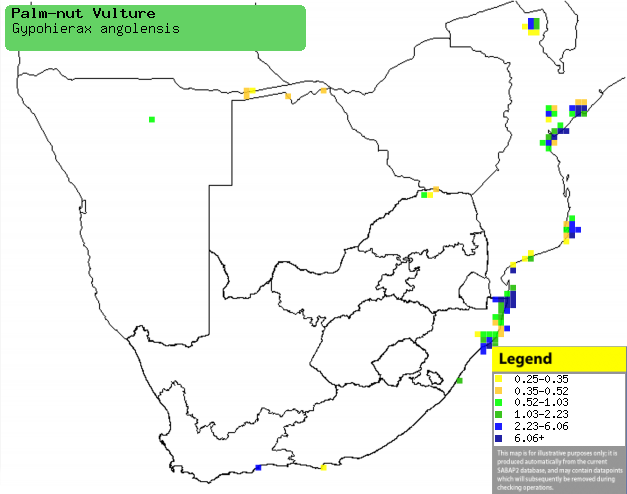|
Gypohierax angolensis (Palm-nut
vulture)
WitaasvoŽl [Afrikaans]; Gungwa, Ngungwamawala [Tsonga];
Palmgier, Gierarend [Dutch]; Palmiste africain [French]; Palmengeier
[German]; Abutre-das-palmeiras [Portuguese]
Life
> Eukaryotes >
Opisthokonta
> Metazoa (animals) >
Bilateria >
Deuterostomia > Chordata >
Craniata > Vertebrata (vertebrates) > Gnathostomata (jawed
vertebrates) > Teleostomi (teleost fish) > Osteichthyes (bony fish) > Class:
Sarcopterygii (lobe-finned
fish) > Stegocephalia (terrestrial
vertebrates) > Tetrapoda
(four-legged vertebrates) > Reptiliomorpha > Amniota >
Reptilia (reptiles) >
Romeriida > Diapsida > Archosauromorpha > Archosauria >
Dinosauria
(dinosaurs) > Saurischia > Theropoda (bipedal predatory dinosaurs) >
Coelurosauria > Maniraptora > Aves
(birds) > Order: Falconiformes
> Family: Accipitridae
Distribution and habitat
Occurs in sub-Saharan Africa, from Gambia to the DRC, with
isolated populations further east and south.
In southern Africa it is uncommon and localised in coastal and northern Mozambique, and KwaZulu-Natal,
while more scarce in the Caprivi Strip (Namibia), northern Botswana, Limpopo
Province and the Eastern and Western Cape. Its distribution is strongly linked
to that of the Kosi palm (Raphia australis) which it is dependent on for
food and nest sites; it may also occupy edges of freshwater lakes, estuaries and
swamps.
|
 |
|
Distribution of Palm-nut vulture in southern Africa,
based on statistical smoothing of the records from first SA Bird Atlas
Project (©
Animal Demography unit, University of
Cape Town; smoothing by Birgit Erni and Francesca Little). Colours range
from dark blue (most common) through to yellow (least common).
See here for the latest distribution
from the SABAP2. |
Movements and migrations
Largely sedentary, although there are
widespread vagrant records across the region, which suggests that it might be nomadic.
Food
It is mainly frugivorous, largely feeding on the fruit of
the Kosi palm (Raphia australis) supplemented with small mammals, frogs,
fish and invertebrates. When feeding on palm fruit it breaks off an
individual fruit from the cluster and takes it to a branch or palm frond,
where it flicks off the scales with its bill so that it can feed on the flesh;
once finished it drops the kernel to the ground and returns to the cluster for
more. The following food items have been recorded
in its diet:
- Plants
- fruit
- Raphia australis (Kosi palm)
- Phoenix reclinata (Wild date palm)
- seeds of Acacia cyclops (Rooikrans)
- Animals
- small mammals
- tree frogs
- snails
- sea-lice
- crabs
- insects
Breeding
- A monogamous solitary nester, it strongly defends its territory against
other Palm-nut vultures and raptors, chasing them away.
- The nest is built by both sexes, consisting of a large platform of
sticks lined with dry grass, other plant fibres and dung. It is typically
placed in the upper fronds of Raphia palms, although it may rarely
use a Eucalyptus tree instead.
- Egg-laying season is from August-September.
- It lays one egg, which is mainly incubated by the female for about 42-47
days.
- The chick is fed by both parents on a diet of mainly animal food at
first, but in the last month before it leaves the nest it is weaned onto
palm fruit, until at about 85-91 days old it leaves the nest and is capable
of collect fruit for itself. It remains in the vicinity of the nest for
about three more months, before becoming fully independent.
Threats
Not threatened internationally, but habitat destruction in
Mozambique is though to be seriously impacting its population there. In the
1970s it was one of the rarest birds in South Africa, with just a few breeding
pairs, but since then it has recovered steadily to at least 12 pairs in 2003. It
is now thought to be under no immediate threat.
References
-
Hockey PAR, Dean WRJ and Ryan PG 2005. Roberts
- Birds of southern Africa, VIIth ed. The Trustees of the John Voelcker
Bird Book Fund, Cape Town.
|
